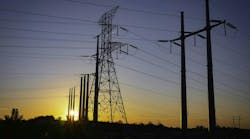In late 2008, on an aerial patrol, three 500-kV towers were discovered with partially collapsed foundations on the line between the Pinard and Porcupine transformer stations on the Hydro One Networks Inc. system. It was a serious problem that needed to be addressed quickly. The line transmits power from the Otter Rapids, Harmon and Kipling generating stations 100 miles (161 km) down to Timmins, Ontario, Canada.
The V-shaped towers are supported by a single pedestal foundation and four guy wires. The buried pedestal foundations are constructed of lattice steel — four legs of angle irons that taper out as they extend down until they are 3 ft (0.9 m) wide. From there, they extend straight down an additional 5 ft (1.5 m). The angles are supported by diagonal members (flat bars and angle irons). The pedestal sits on top of a network of steel angles and timber mats. No concrete is involved.
After the helicopter patrol found the problem, a ground-based patrol went out to assess the situation. The site is marshy, and during the winter, frost heaves the ground up and down. This movement tore some of the diagonals off of the grillage footing. Without the support of the diagonal members, the main foundation legs bent and the foundation began to give way. Three structures had partially collapsed, but they had not completely tipped.
Quick repair was required to prevent a complete failure of the foundations, but access to the structures with large equipment or a crane was not possible without extensive road construction. Instead, a temporary repair was made. Hydro One's Sudbury traveling line crew installed blocking to carry the weight of the structures until permanent repairs could be made. Winter was fast approaching, so it was too late to do anything else in 2008.
A Solution
In the 1980s, Hydro One had used some A.B. Chance piles under similar conditions, but no one who worked on that project was still around and the work was not well documented. But, after reviewing the situation, it was decided horizontal beams welded onto helical piles would be the best option. With this approach, there would be no need to excavate or remove and replace the existing foundations. This would obviate the need to bring in big earthmoving equipment.
After contacting Hubbell Power Systems, one of its experts met with the Hydro One engineering design team. Together, they reviewed the soil characteristics and defined what load the piles would have to support. Knowing good load-bearing data would be needed for the site, they drilled pins into the ground to measure installation torque. About 7 ft (2 m) of poor material was found and, below that, good load-bearing clay.
The team also considered the length of the pier sections. There were some concerns about clearance with the tower during installation. Consideration also was given to the torque capacity of the drive motor. The Hubbell Power Systems representative used the information to design the anchoring system.
Hydro One also considered possible environmental issues and concerns. Fortunately, the site was not in a special-treatment area, something that is checked whenever a right-of way must be entered.
The Big Fix
Permanent repairs were made in early 2009. The work was performed by the Sudbury traveling line crew under the direction of crew supervisor Rob Beange. He and his crew came up with some innovative ideas that allowed the work to be executed safely and effectively. The crew installed the piles at the three towers in two days. The work would have been finished sooner, but there was some distance between the towers. It took one day per tower to finish the work.
To begin, a drive motor was installed on an excavator, which was used to install the helical piles through the weak soil and into the underlying clay. The crew used an excavator rather than a radial boom digger, because the operator could better control the drive motor and install the piles at a more precise angle. The crew also built a jig to use as a visual reference. The jig was a tripod with the legs angled at the correct drilling slopes (in two different directions). The driller could compare the angle of the piles being driven to the slope of the jig. This angle was important because the helical piles had to be fairly close to the base of the tower at the top, but they had to taper away from the tower to provide lateral stability and clear the grillage foundation below it.
The operator augered the piles in at the appropriate slope until reaching the required installation torque. That occurred at various depths, but, on average, they were about 20 ft (6 m) down. The lead section of the helical piles was 7 ft (2 m) long and 2 inches (51 mm) in diameter, with three staggered helix-plate diameters of 10 inches (254 mm), 12 inches (305 mm) and 14 inches (356 mm). Two extensions, each 10 ft (3 m) long and 8 inches (203 mm) in diameter, were then used.
Once driven in, the piles were cut off horizontally at the precise elevation that would allow for the installation of the I-beams without requiring any change in the tower elevation. (The towers were actually raised a bit. It took about a half of a 0.75-inch (19-mm) bolt hole. That was just enough room to allow the bolts to be wiggled out.) Once the I-beams were welded in place, they had to be perfectly horizontal, and all the I-beams under each tower had to be at exactly the same elevation. To do this, a laser level was used.
Hydro One also hired a welder to weld the I-beams across the piles perpendicular to the direction of the line. These beams became the platform for the first set of temporary I-beams that were placed parallel to the direction of the line and used as a base to jack up the towers. Next, workers cut off the top part of the grillage below grade, leaving the rest in place. Then, permanent support beams were slid in and welded in place. The tower was then lowered onto the new beams and the guy wires were retensioned.
There was not much excavation during the project. At each site, once a hole was dug, it filled with water. Luck was with the work crews at a couple of locations. A 2-ft (0.6-m)-deep excavation did not have much water enter. The welder suffered the most. He had to lie in the hole on his back to weld the beams to the anchors after grinding the galvanizing off of the anchors. All work was completed by August 2009, and there have been no further problems with frost heave at those locations.
Project Documentation
This project was carefully documented. The engineers determined and recorded all the weights and tensions for the work, and then created a job document, a step-by-step guide of what needed to be done. When the work started, a work methods technician went out to the site to document the work on the first structure. There is now a well-documented job procedure ready for the next person who might have to make a similar repair 20 years from now.
Doug Hudspeth ([email protected]) graduated from Mohawk College of Applied Arts and Technology in 1987 as an electrical control engineering technologist. He joined Ontario Hydro, the predecessor to Hydro One Networks, in 1988. He worked on a variety of transmission line maintenance projects as a technician before becoming the manager of transmission line technicians.
Companies mentioned:
A.B. Chance | www.abchance.com
Hubbell Power Systems | www.hubbellpowersystems.com
Hydro One | www.hydroone.com

